A brief history of saved games
(Originally published in 2019.)
A modified version of this article ran on Tedium as well. I’m very grateful to Tedium’s editor, Ernie, for the additions he made to the version there and the opportunity to share my writing with his audience.
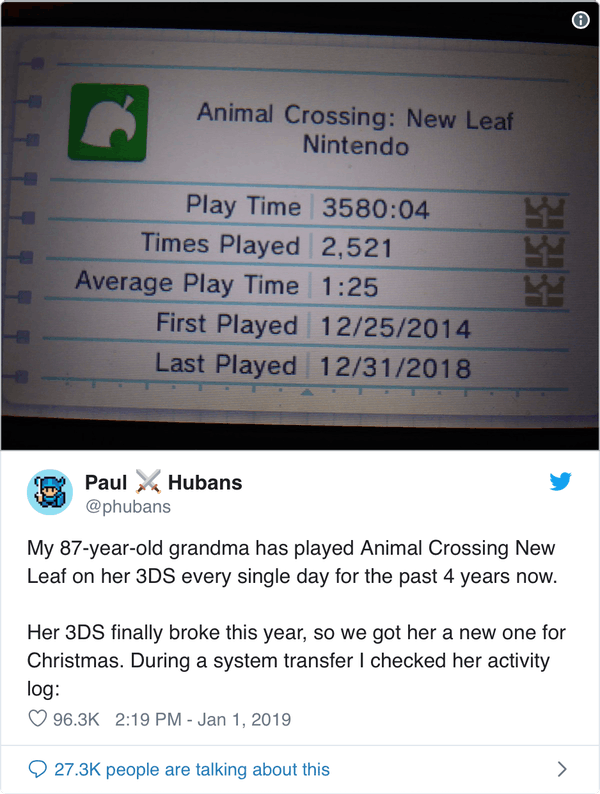
Earlier this year, a Twitter user named Paul Hubans shared a screenshot from his 87 year old grandmother’s long-running Animal Crossing session; after four years of daily play, she had logged 3,580 hours—nearly 150 days—of total playtime.
Being able to save progress in a game and return to it later has enabled some amazingly deep experiences. It wasn’t always like this, so how did we get here? Let’s find out by taking a look back at the history of saved games.
(Before we begin, it’s worth pointing out that home computers had a very different set of trade-offs than video game consoles, and saved games were pretty much there from the beginning for computer gamers. This article is focused on the history of saving games on gaming consoles, which was a much more interesting journey.)
You had me at ‘Pong’
In the beginning, there was…not much. Video games were simple, ephemeral experiences—put a quarter into the Pong machine, play until you lose the game, and then move on with your life. The earliest commercial video games were built using discrete logic components, rather than more capable microprocessors1, and this put a cap on the complexity of the gaming experiences they could offer. Fortunately, for folks living through the dawn of video gaming in the mid-1970s, it was more than exciting enough.
Things began to change in the late 1970s, as the cost of microprocessors fell and home computers became more accessible for the average consumer. This led to the first great divide in video gaming: one one side you had the pure gaming experiences offered in arcades and on dedicated home video consoles, and on the other side you had the the different set of gaming experiences that multi-purpose home computers could offer. Home computers generally lagged far behind dedicated gaming consoles in terms of graphics and sound capabilities, but had an early lead in data storage, at first thanks to floppy disks and later due to capacious hard disks. It would be a long time before game consoles caught up in that regard, keeping the focus on fast arcade action and away from deep, exploratory experiences.
Home video game systems like the Atari 2600 and Nintendo Entertainment System stored their games on cartridges containing ROM chips—read-only memory. Even if game developers wanted to offer more than simple arcade games, there just wasn’t anything for progress to be saved on.
The solution? Passwords.
Magic Words
The first home game to feature a password system was 1983’s Survival Island for the Atari 2600. Although primitive by today’s standards, Survival Island was a technical tour de force, featuring a large world to explore, the ability to populate and maintain an inventory of items, 3D mazes and, of course, passwords to let you pick up where you left off the next time you wanted to play. It’s one of just a handful of 2600 games to feature a password at all.
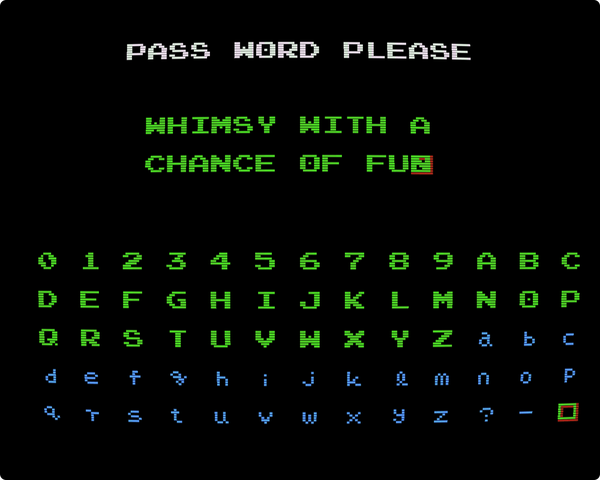
Passwords really hit their stride on the Nintendo Entertainment System a few years later. The NES was a technological leap beyond the 2600 and could offer much richer gaming experiences. Password-backed games began appearing a little more than a year into the NES’s North American lifetime, starting with Konami’s May 1987 release of Castlevania. By June of that year, Nintendo itself was promoting a line of “Password Pak”-branded games at the summer CES trade show2, starting with Kid Icarus and Metroid.
Passwords caught on in a flash, and it was common for gamer kids to keep a notepad next to their controller. Passwords were both treasured and traded, shared on playgrounds and even published in magazines and books3.
Passwords opened up a new level of possibilities for gaming, but they were still limited. Passwords could only store so much information before becoming unreasonably long, and even writing down even short passwords was still a distraction from playing the games. In Japan, both of Nintendo’s premiere Password Paks had been released on the Japan-only floppy disk drive add-on for their home console. Using a floppy disk meant that progress could be saved directly on the game disk itself, freeing players from the tedium of copying down passwords on slips of paper and the responsibility of keeping track of them afterwards.
What the world needed was another technological leap. How could progress be saved onto game cartridges that were inherently read-only?
Batteries Included
Nintendo announced the next leap at the very same trade show that unveiled their Password Paks. The Legend of Zelda, already available in Japan on floppy disk, would be coming to North America on a cartridge. Instead of passwords, it would feature the same true saving system as its Japanese counterpart. Nintendo pulled this off with a clever piece of engineering: inside of the cartridge was a small, long-lasting battery that effectively tricked the game into thinking it was never turned off, allowing it to store progress for up to three different gaming sessions.
The Legend of Zelda wasn’t the first battery-backed cartridge4 or even the first game to use a battery backup5, but it was still a major leap forward. Previous battery-backed cartridges required gamers to insert their own AA batteries, making the cartridges awkward and heavy. The Legend of Zelda, on the other hand, just seemed like an ordinary game.
Nintendo had originally planned to bring their disk drive add-on to consoles around the world, but the Legend of Zelda—a marquee disk title just the year before in Japan—ended up being the the final nail in the coffin for the add-on instead. The Nintendo Disk System had initially been developed to provide more space for larger games and the ability to save a player’s progress as they went, but advances in cartridge technology rendered them obsolete within the year. Cartridge capacities had grown ever larger, and with the advent of battery-backed saving, both of the disk’s major innovations had made their way to vanilla consoles.
Over the next few years, both passwords and batteries would grow in popularity. At first, passwords were the go-to solution for simple progression, with batteries reserved for more complex adventure and role-playing games. But as the 1980s bled into the 1990s, battery-backed saving became more commonplace. Of the five launch titles for Nintendo’s second North American home console, two would feature battery-backed saving.
Memory Cards
Cartridges had successfully fended off the threat of obsolescence once before, but at the dawn of the decade, they faced a new challenge: CD-ROMs. First available to Japanese console gamers with NEC’s 1988 add-on for their PC Engine console (North America’s TurboGrafx-16), the technology started going mainstream in the West with Sega’s 1992 add-on for their much more popular Genesis console. Games on CD-ROM offered a tremendous leap in storage capacity, hundreds of times larger than any cartridge of the day, but had an Achilles Heel—they had no way to store a player’s progress. Unlike cartridges, which were flexible enough to incorporate innovations like battery-backed saving within their hard plastic shells, CDs were just CDs. There would be no clever new add-ons within.
The solution? To keep using cartridges, sort of. Both NEC and Sega included memory for save games into their CD-ROM consoles, but Sega went a step further by also introducing their CD Back Up RAM Cart, which not only increased the space available for saved games, but also made it possible for players to bring their save games over to other consoles when visiting their friends. The Back Up RAM Cart effectively took the battery-backed saving technology of the Legend of Zelda and put it in a cartridge all by itself, sans game6.

(Not shown to relative scale.)
Subsequent disc-based consoles of the 1990s embraced the concept of memory cards with open arms. Sega’s follow-up console, the Saturn, followed the same internal memory + backup cartridge model as the Sega CD, but it proved to be an aberration. Sony’s PlayStation and all subsequent disc-based systems from the major players used memory cards exclusively. Even the Nintendo 64, famous for being a cartridge-loving holdout in the age of optical discs, offered memory cards (although plenty of its games still used battery-backed cartridges instead).
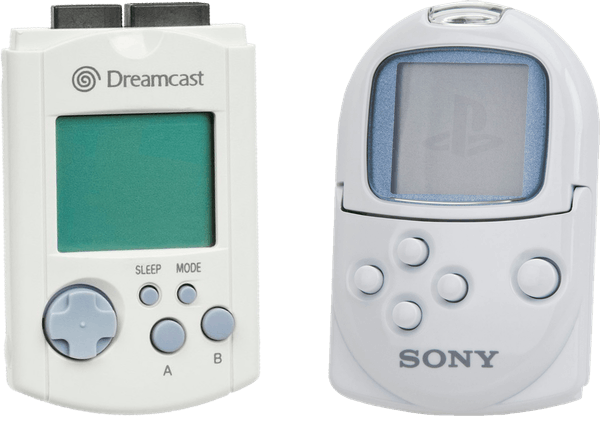
Right: Sony PocketStation memory card
The high point of memory cards was probably the release of the Sega Dreamcast, which featured so-called Visual Memory Units in place of ordinary memory cards. These memory cards were tiny game systems of their own, capable of holding saved games but also of downloading software from their host system. The VMU made entirely new experiences possible. For example, Sonic Adventure let players transfer Tamagotchi-like “Chao” to their VMUs, where they could level up their stats while away from their gaming console. Sony attempted to match this capability with their PocketStation line of peripherals for the PlayStation, but the idea didn’t really catch on. This made smart memory cards more of a historical curiosity than a glimpse of the next big thing.
Arcades
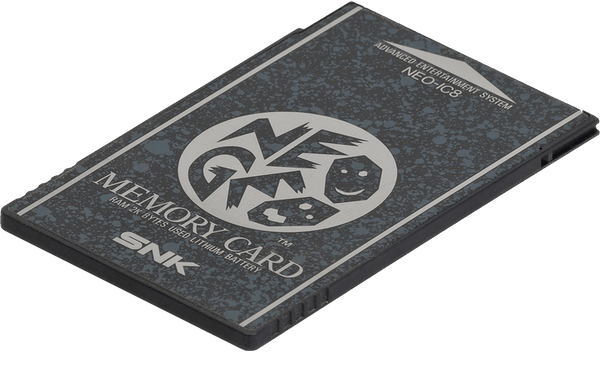
Gamers quickly took to the idea of bringing their saved games with them when they left home. In addition to letting players share their progress and collaborate, memory cards also gave them an avenue for sharing competitive information and records of their gaming prowess. Inevitably, arcade games saw an opportunity to enhance their appeal, leading to a handful of memory card-compatible arcade experiences.
The first company to bring this idea to market was SNK, a publisher that’s mostly known for fighting games. These sorts of one-on-one games bred plenty of healthy competition between gamers, making them a natural fit for the idea of saving high scores and personal records. When SNK released a home console—effectively a repackaged version of their arcade hardware—including support for memory cards there, too, made sense.
Konami’s Dance Dance Revolution offers another popular example of arcade memory card use. Some DDR arcade cabinets were equipped with Sony PlayStation memory card slots, allowing gamers to save their customizations and high scores between sessions, and some customizations from the home console carried over to the arcade game.
Nintendo got in on the idea with 2003’s F-Zero AX, an arcade peer to F-Zero GX, released on the GameCube in the same year. F-Zero AX had a GameCube memory card slot, and much like DDR, allowed the player to bring customizations from their home game into the arcades.
Mass Storage & Auto-saves
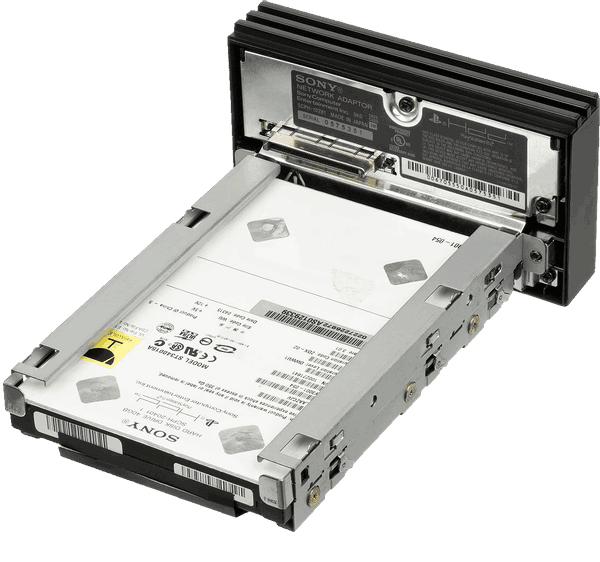
Despite their convenience, memory cards had one huge drawback: storage capacity. Around the turn of the century, the industry transitioned from battery-backed memory to non-volatile flash memory—the same thing you’d find in a USB flash drive or a camera’s memory card. Unfortunately, flash memory was still wildly expensive back then, meaning memory cards remained cramped. Frustrated gamers had to adopt a mercenary sort of attitude while digging through the contents of their memory cards, trying to make room for a new game by deleting their progress in another.
An alternative to memory cards appeared during the sixth generation of consoles. Microsoft’s first Xbox made history as the first console to come with a hard disk built in as standard equipment, and the PlayStation 2 supported hard drives as an optional add-on. Hard disks opened up a lot of new possibilities for gamers, including what was effectively unlimited storage for saving gamers’ progress.
Both the PlayStation 2 and Xbox supported traditional memory cards as well, but their 8 MB capacities were nothing compared to the hard disks inside the consoles themselves (4 or 8 GB for the Xbox and a whopping 40 GB for the PlayStation 2). The reign of the memory card was over.
With all of that space available, gamers were finally free of the dreaded “what will I miss least?” decision making process associated with making room on their memory card. Better yet, games could begin assuming that they were always allowed to save—rather than an event that might happen at the end of a play session, saving progress could happen much more often, and without necessarily overwriting what had been saved before. This, pardon the pun, really was a game-changer, leading to the invention of auto-saves. Auto-saves meant that the game itself decided when it should save the player’s progress, freeing gamers from yet another bit of minutiae and saving them from unpleasant events like power outages or game freezes that might’ve led to a loss of progress in years gone past. Some games even manage to leverage auto-saves to discourage cheaters7.
Cloudy With A Chance of Backups

By the time the seventh generation of home consoles landed in 2005, both hard disks and network connectivity were standard features. At first, that connectivity was focused on online multiplayer gaming, but over time, more and more network-aware features appeared in consoles. Sony and Microsoft both added cloud saves to their consoles within the span of a few months in 201189, untethering save games from physical hardware and giving gamers the freedom to pretty much stop thinking about them.

Putting saved games on the cloud had a number of advantages, the most obvious being safety. If your console met some unpleasant fate—a very real possibility for Xbox 360 users—at least you wouldn’t lose your precious saved games. And on a more upbeat note, you were also free to sign in to your account on a friend’s console and pick up where you left off (assuming you had a copy of the game with you). After a decade of being trapped inside of memory cards and hard disks, saved games were untethered and free for the first time.
What’s Next?
Over the past three decades, saved games have moved from scraps of paper to cartridges to memory cards to hard drives to…somewhere out on the internet. With the move to the cloud, save games have probably achieved their ultimate form. Storage and connectivity are so commonplace that many games just continuously save progress in the background.
At the same time, we may all have lost something special. Kids in the 80s traded passwords on scraps of paper. Kids in the 90s stuffed memory cards in their backpacks and brought their games over to friend’s houses. Kids in the 2000s gained the amazing ability to play against each other no matter where they were, but lost that little bit of magic that came from taking care of a precious physical thing.
No one would want to go back to the way things were, but it’s still worth remembering. Next time you notice a “saving…” animation in the corner of your screen, take a moment to think about how far we’ve come. It’s really pretty amazing.
Here’s hoping Paul Huban’s grandmother’s new 3DS is good for another 3,000 hours of Animal Crossing.
Many thanks to my patient and helpful wife, Nathalie, for copyediting this article, and to Ernie Smith of Tedium for suggesting I expand the scope from a history of memory cards to the entire history of save games.
Footnotes
- The first microprocessors went on the market in 1971, about a year before the release of Pong, so it’s not surprising that early games weren’t using microprocessors from the very start. ↩︎
- CES: Nintendo Shows Off Password Pak Technology ↩︎
- Nintendo themselves got in on the action, publishing a book called Top Secret Passwords in 1992. ↩︎
- Nintendo had first used the concept with a programming environment called Family BASIC for their Japanese console in 1984. ↩︎
- That honour belongs to a 1985 game called Pop & Chips, released on an obscure console called the Super Cassette Vision. You can see a photograph of the cartridge (which required two AA batteries) in this comment from a user named Pirate Dragon. ↩︎
- Sega wasn’t the first to bring the idea of memory cards to home console—SNK’s 1990 release of their Neo-Geo AES beat them to market by more than a year. Although the AES was a cartridge-based system (and theoretically could’ve used battery-backed saves like other consoles), it used memory cards in order to support interoperability with their arcade cabinets. ↩︎
- Most of the MegaMan Battle Network games auto-save the game before revealing the result of a trading minigame, preventing players from resetting if they don’t like the result. (Source) ↩︎
- IGN, March 9, 2011: PS3 Game Saves Move to the Cloud ↩︎
- The Next Web, July 5, 2011: Microsoft begins moving Xbox 360 profiles and saved games to the Cloud ↩︎
See also
- Atari Mania: Survival Island
- Cart Wars: The Evolution of the Cartridge
- Wikipedia: Dance Dance Revolution hardware
- Wikipedia: Family Computer Disk System
- Wikipedia: Memory cards
- Wikipedia: PlayStation (console)
- Wikipedia: PlayStation 2
- Wikipedia: PocketStation
- Wikipedia: VMU
- Wikipedia: Xbox (console)